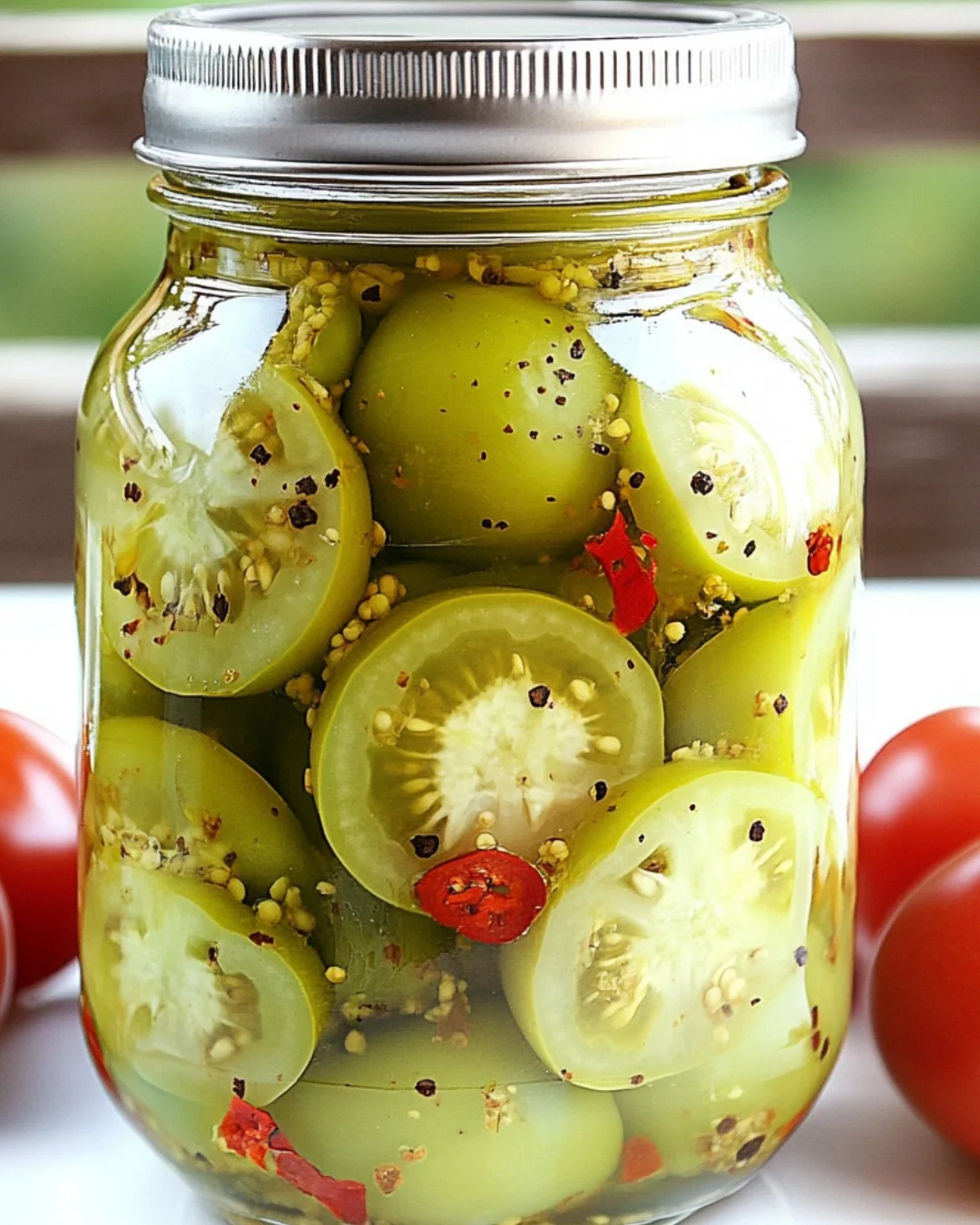Pickled green tomatoes are a hidden gem in the world of pickling. While most people associate pickles with cucumbers, green tomatoes offer a unique texture and tangy flavor that makes them an excellent alternative. With their crisp bite, savory brine, and a hint of spice, these pickled treats can be used in countless ways—whether as a snack, a sandwich topper, or an unexpected addition to charcuterie boards.
If you’ve ever found yourself with an abundance of unripe tomatoes at the end of the growing season, pickling is one of the best ways to preserve them. In this guide, we’ll dive into the origins of pickling, the science behind perfect pickled green tomatoes, expert tips for the best texture and flavor, creative uses for your pickles, and common mistakes to avoid.
A Brief History of Pickling
Pickling is one of the oldest food preservation techniques, dating back thousands of years. The process likely originated over 4,000 years ago in Mesopotamia, where people used a mixture of salt and vinegar to extend the shelf life of perishable foods.
Green tomatoes, though not as commonly pickled as cucumbers, have been a staple in Southern and Eastern European cuisines for generations. Their naturally firm texture holds up well in brine, making them a fantastic candidate for pickling.
As food preservation methods evolved, quick refrigerator pickles gained popularity, offering a way to enjoy pickled foods without the need for complicated canning techniques. Today, pickled green tomatoes have found their way into modern kitchens as a versatile, crunchy, and flavorful snack.
Ingredients
Pickled Green Tomatoes
- 2 pounds green tomatoes, quartered
- 2 cloves garlic, peeled and crushed
- 1 quart-sized canning jar with lid, sterilized
- 1 cup distilled white vinegar (5% acidity)
- 1 cup water
- 2 tablespoons kosher salt
- 1 tablespoon sugar
Pickling Seasoning
- 1 tablespoon mustard seeds
- 1 teaspoon black peppercorns
- 1 teaspoon pink peppercorns (or substitute with black peppercorns)
- ½ teaspoon dried dill
- ¼ teaspoon ground coriander
- 2 bay leaves, crumbled
Directions
- Prepare the Pickling Seasoning
- In a small bowl, mix mustard seeds, black and pink peppercorns, dried dill, coriander, and crumbled bay leaves. Set aside.
- Prepare the Tomatoes
- Clean and quarter the green tomatoes. Place them in the sterilized quart-sized jar along with crushed garlic.
- Make the Pickling Liquid
- In a saucepan, combine white vinegar, water, kosher salt, and sugar. Heat over medium, stirring until the salt and sugar fully dissolve.
- Infuse the Seasoning
- Add the prepared pickling seasoning to the saucepan. Bring the mixture to a boil, then remove from heat.
- Assemble the Pickles
- Pour the hot pickling liquid over the tomatoes and garlic in the jar. Ensure all ingredients are submerged, leaving about ½ inch of space at the top.
- Seal and Store
- Tap the jar gently on the counter to release air bubbles. Secure the lid and let the jar cool to room temperature before refrigerating.
- Wait and Enjoy
- Allow the pickles to rest for at least 24 hours before eating. For the best flavor, let them sit for 48–72 hours before enjoying.
Nutritional Information (Per Quart Jar)
- Calories: 316 kcal
- Total Fat: 0.4g
- Carbohydrates: 60.2g
- Fiber: 11.9g
- Sugar: 37.1g
- Protein: 10.6g
The Science Behind Perfect Pickled Green Tomatoes
The magic of pickling lies in the balance between acidity, salt, and seasoning. Here’s how each component plays a role:
1. The Role of Vinegar
Vinegar is the key ingredient in pickling because it creates a highly acidic environment that prevents bacterial growth. Distilled white vinegar is the best option for pickled green tomatoes because it has a clean, neutral flavor that enhances the tomatoes’ natural tartness.
2. Salt for Flavor and Preservation
Salt draws moisture out of the tomatoes, helping to create the perfect crisp texture while enhancing the overall flavor. Kosher salt is preferred because it dissolves easily and doesn’t contain iodine, which can sometimes cause bitterness.
3. The Sweetness Factor
A small amount of sugar balances the acidity of the vinegar, creating a more complex flavor profile. It also enhances the natural sweetness of the tomatoes, preventing them from tasting overly sour.
4. The Power of Pickling Spices
Using whole spices such as mustard seeds, black peppercorns, bay leaves, and coriander infuses the pickling brine with layers of aromatic depth. Over time, the tomatoes absorb these flavors, transforming them into a tangy, savory treat.
5. The Importance of Submersion
For pickling to be effective, the tomatoes must remain fully submerged in the brine. This ensures even flavor distribution and prevents spoilage.
Expert Tips for the Best Pickled Green Tomatoes
1. Choose the Right Tomatoes
Not all green tomatoes are created equal. Look for firm, unripe tomatoes with a vibrant green color. Avoid tomatoes that have started ripening (turning slightly yellow or orange), as they tend to become mushy when pickled.
2. Don’t Skip the Waiting Period
While pickled green tomatoes can be eaten after 24 hours, they develop their best flavor after 48–72 hours. The longer they sit, the deeper the flavors become.
3. Use Glass Jars for Pickling
Always store your pickled tomatoes in sterilized glass jars. Plastic containers can absorb odors, and metal containers may react with the vinegar.
4. Experiment with Flavor Additions
Once you’ve mastered the basic recipe, try adding red pepper flakes, cinnamon sticks, or even a splash of hot sauce for a spicier variation.
5. Keep Your Pickles Refrigerated
Since this recipe uses the quick pickling method, the tomatoes must be stored in the refrigerator to remain safe to eat. They are not shelf-stable like canned pickles.
Creative Ways to Use Pickled Green Tomatoes
Pickled green tomatoes are incredibly versatile. Here are some delicious ways to incorporate them into your meals:
1. As a Standalone Snack
Enjoy them straight from the jar for a refreshing, crunchy snack. Their tangy flavor makes them addictive.
2. On Sandwiches and Burgers
Swap out traditional pickles for pickled green tomato slices on sandwiches, burgers, or wraps. They add a bold, zesty bite that pairs well with meats and cheeses.
3. In Salads
Chop pickled green tomatoes and toss them into salads or grain bowls for a punch of acidity and crunch.
4. As a Bloody Mary Garnish
Upgrade your cocktail game by using pickled green tomato slices as a garnish in Bloody Marys or other savory cocktails.
5. On a Charcuterie Board
Serve them alongside cheese, cured meats, and olives for an elegant, tangy addition to any charcuterie board.
6. Fried Pickled Green Tomatoes
Pat them dry, coat them in breadcrumbs, and fry them for a crispy, flavorful twist on the classic Southern dish.
Common Mistakes to Avoid When Pickling Green Tomatoes
1. Using Overripe Tomatoes
If tomatoes have started ripening, they will become too soft after pickling. Stick with firm, fully green tomatoes.
2. Not Sterilizing the Jars Properly
Clean, sterilized jars prevent contamination and extend freshness. Always wash your jars in hot, soapy water before using.
3. Not Letting the Brine Cool Slightly
Pouring boiling-hot brine directly over the tomatoes can cause them to cook slightly, affecting their crispness. Let the brine cool for a couple of minutes before pouring.
4. Not Ensuring Full Submersion
If the tomatoes are not fully covered in liquid, they may spoil or develop an off taste.
5. Overloading the Pickling Liquid with Sugar
Too much sugar can overpower the natural tanginess of the tomatoes, so stick to a balanced ratio.
Frequently Asked Questions (FAQs)
1. How Long Do Pickled Green Tomatoes Last?
They will last up to one month in the refrigerator, provided they remain fully submerged in the brine.
2. Can I Use Apple Cider Vinegar Instead of White Vinegar?
Yes, apple cider vinegar will add a slightly fruity, mellow flavor, making it a great alternative.
3. Can Pickled Green Tomatoes Be Canned for Long-Term Storage?
This recipe is for quick refrigerator pickles, not for canning. If you want a shelf-stable version, you’ll need to follow a proper canning process with sterilized jars and a boiling water bath.
4. Are Green Tomatoes the Same as Tomatillos?
No, green tomatoes are unripe red tomatoes, while tomatillos are a completely different fruit with a papery husk and a more tart flavor.
5. Why Did My Pickled Tomatoes Turn Mushy?
Mushiness is often caused by using overripe tomatoes or overcooking them with too-hot brine.
Conclusion: The Perfect Pickle for Any Occasion
Pickled green tomatoes are a delicious way to preserve the last of your summer harvest while adding a tangy crunch to your meals. With their sharp acidity, satisfying texture, and endless versatility, they deserve a spot in every kitchen.
Whether you enjoy them as a snack, on a sandwich, or as a unique cocktail garnish, these pickles offer a delightful balance of tart, salty, and slightly sweet flavors. Once you try them, they might just become a staple in your refrigerator.
Are you ready to transform your green tomatoes into something truly special?





